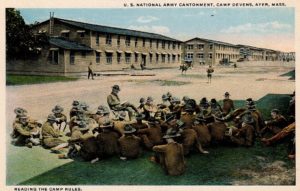
Fort Devens, a military base in Massachusetts, served as a training and deployment facility during World War I and World War II. The Army operated in segregated units during World War I and World War II causing racial tensions and great injustices for people of color. The racial tensions and injustices that a segregated army created is well-documented by scholars, but academic work tends to ignore two key points in the narrative. Until recently, scholars largely ignored the diverse backgrounds that African-American military personnel came from, failing to view the black experience as individual and dynamic. The African-American soldiers were often lumped together in one large mass of similar experiences of uneducated, poor southern African-American males conscripted into the army. This is not the case. The second key point scholars ignore is the role northern civilian and military communities played in both supporting, and eventually, dissolving a segregated army. While it is recognized that racial tensions did exist in Northeastern communities during World War I and World War II, the South exploded with such racial hatred that the North looked like a haven of peace and equality. Yet looking through newspaper articles from Massachusetts during World War I and World War II, the racial stereotypes and prejudices that northerners exhibited becomes evident. And given the strong civil rights movements on one military base in Massachusetts during World War II, we can see how the racial stereotypes of the World War I era fueled the flames for African-Americans to fight against a segregated army and for equality in the military.
The story of segregation at Fort Devens illustrates the long struggle for African American equality in the United States. With each generation, building blocks were established that the next generation stepped on and allowed others to reach for higher goals. The example of Fort Devens widens the scope of civil rights unrest and protest to include African-American women and African-American men who were not born into southern Jim Crow laws or in black communities. These men and women entered a government institution whose policy was segregation, even as they themselves tried to use this institution to create a better life for all African-Americans. Despite southern Jim Crow laws stretching into policies of the U.S. Army and prejudiced attitudes that African-American military personnel faced, the African-Americans serving at Fort Devens successfully voiced their opinions and showed the world who they were, on their terms, by their actions. No matter what lengths the army took to segregate African-Americans from white people, or from each other, African-Americans turned a bad situation into an opportunity to unite, and fight for that “Double V” victory.
